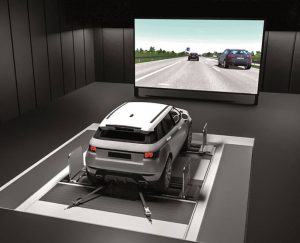AVL’s Driving Cube is designed to enable reproducible testing of driver assistance systems and driving features for self-driving vehicles using a real vehicle within a virtual environment. Test drives are performed with a real vehicle on a chassis dynamometer or powertrain testbed.
These virtual driving scenarios can test a vehicle’s peripheral sensors, control systems and actuators.
Following this collaboration, the Driving Cube’s range of simulations now includes GNSS signals.
The vehicle’s receiver is stimulated using signals generated on the testbed. This way, technical engineers can identify how sensors, automated driving features and other actuators respond inside the vehicle.
Rohde & Schwarz GNSS stimulators are used (SMBV100B or SMW200A), which allow the generation of signals for all of the available satellite navigation systems (GPS, Glonass, Galileo, BeiDou, QZSS, SBAS) across all frequency bandwidths (L1, L2, L5).
This makes them suitable for testing multi-frequency receivers, which are playing an increasingly important role in automated driving.
The stimulators form a modular system that can be integrated into the test environment. The stimulator is controlled automatically from the simulation platform. R&S’s extensions for AVL Driving Cube are available with immediate effect.
Dr.-Ing. Tobias Düser, head of advanced solution lab at AVL Deutschland GmbH says “In Rohde & Schwarz, we now have a strong and reliable partner for GNSS stimulation. By generating consistent GNSS signals in connection with environment simulation, AVL Driving Cube now provides a test system that allows users to validate GNSS-based driver assistance systems and autonomous driving features.”
 Electronics Weekly Electronics Design & Components Tech News
Electronics Weekly Electronics Design & Components Tech News



